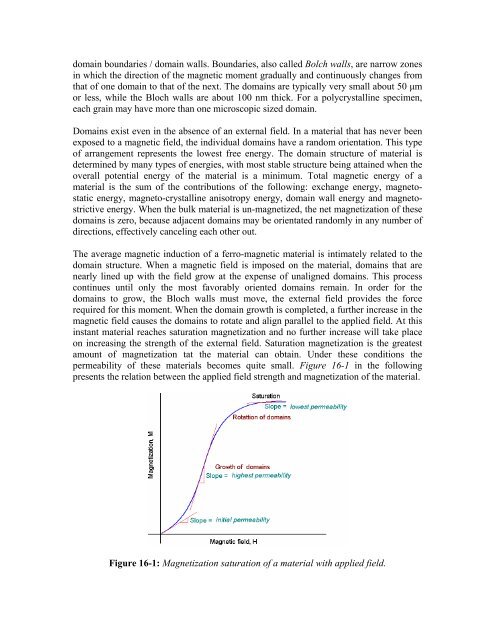Module 16 - E-Courses
Module 16 - E-Courses
Module 16 - E-Courses
You also want an ePaper? Increase the reach of your titles
YUMPU automatically turns print PDFs into web optimized ePapers that Google loves.
domain boundaries / domain walls. Boundaries, also called Bolch walls, are narrow zones<br />
in which the direction of the magnetic moment gradually and continuously changes from<br />
that of one domain to that of the next. The domains are typically very small about 50 µm<br />
or less, while the Bloch walls are about 100 nm thick. For a polycrystalline specimen,<br />
each grain may have more than one microscopic sized domain.<br />
Domains exist even in the absence of an external field. In a material that has never been<br />
exposed to a magnetic field, the individual domains have a random orientation. This type<br />
of arrangement represents the lowest free energy. The domain structure of material is<br />
determined by many types of energies, with most stable structure being attained when the<br />
overall potential energy of the material is a minimum. Total magnetic energy of a<br />
material is the sum of the contributions of the following: exchange energy, magnetostatic<br />
energy, magneto-crystalline anisotropy energy, domain wall energy and magnetostrictive<br />
energy. When the bulk material is un-magnetized, the net magnetization of these<br />
domains is zero, because adjacent domains may be orientated randomly in any number of<br />
directions, effectively canceling each other out.<br />
The average magnetic induction of a ferro-magnetic material is intimately related to the<br />
domain structure. When a magnetic field is imposed on the material, domains that are<br />
nearly lined up with the field grow at the expense of unaligned domains. This process<br />
continues until only the most favorably oriented domains remain. In order for the<br />
domains to grow, the Bloch walls must move, the external field provides the force<br />
required for this moment. When the domain growth is completed, a further increase in the<br />
magnetic field causes the domains to rotate and align parallel to the applied field. At this<br />
instant material reaches saturation magnetization and no further increase will take place<br />
on increasing the strength of the external field. Saturation magnetization is the greatest<br />
amount of magnetization tat the material can obtain. Under these conditions the<br />
permeability of these materials becomes quite small. Figure <strong>16</strong>-1 in the following<br />
presents the relation between the applied field strength and magnetization of the material.<br />
Figure <strong>16</strong>-1: Magnetization saturation of a material with applied field.

















